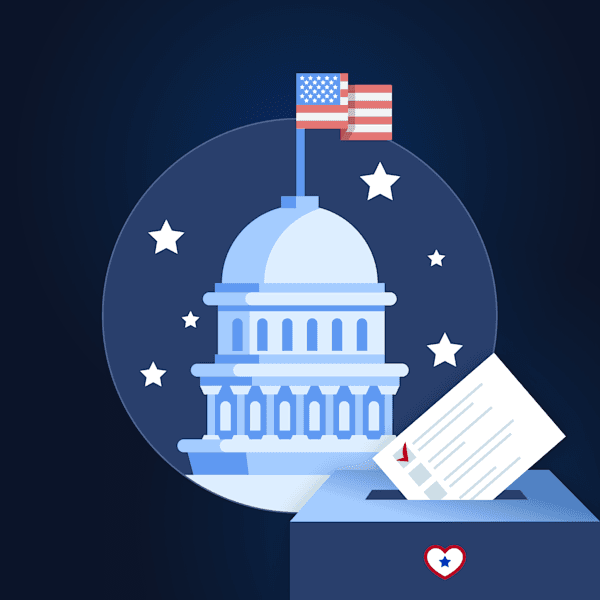
Why Does the United States Have a Two-Party System?
- How Did the Two-Party System Develop in the United States?
- Why Does the United States Continue to Have a Two-Party System?
- The Growing Movement for Change
Arguably, the biggest problem with the American political system is the perception that it has become an entrenched, dysfunctional duopoly that represents corporate and self-interests rather than the people. This has led to widespread voter mistrust, voter fatigue, and political disengagement.
There are currently more than 50 political parties registered in the United States, but you wouldn’t know it when election season rolls around.
The United States has long been characterized by its two-party political system, where the Democratic and Republican parties dominate. Of the 100 current senators, only two are unaffiliated with an establishment party. Aside from George Washington, the United States has also never elected a president outside of the two dominant parties of the time.
This was not the intention of the nation's founders, many of whom distrusted the idea of political factions. Read on as we explore the questions of why does the U.S. have a two-party system and why the two-party system doesn't work.
How Did the Two-Party System Develop in the United States?
The U.S. political system didn’t always operate as a strict two-party model. The evolution of the two-party system took shape over time, influenced by key moments in American history and our socio-political development.
For example, the Federalists and Anti-Federalists were an early example of opposing parties in the United States. One side, the Federalists, were in favor of ratifying the Constitution, while the other opposed ratification.
These two factions largely dissolved once the Constitution was established as a framework for our government and put into effect. However, divisions began to grow during George Washington’s first term, with parties forming around two other prominent political figures with opposing views about the direction of our country, Alexander Hamilton (The Federalists) and Thomas Jefferson (Democratic-Republicans).
Over time, a variety of historical, structural, and cultural factors have solidified the two-party system, making it difficult for third parties to gain a foothold. Understanding how this system developed and why it persists is key to understanding why America has a two-party system and recognizing the challenges faced by independent and third-party movements today.
The Founders' Distrust of Two-Party Systems
In the early years of the Republic, there was a strong desire to avoid partisan conflicts, and some believed that political parties would act as a destructive force. Many of the United States' Founding Fathers, including George Washington and John Adams, were deeply suspicious of political parties.
Why did Washington distrust the two-party system? He warned against the dangers of factions in his Farewell Address, arguing that they would lead to divisions and corruption.
In his own words:
“The alternate domination of one faction over another, sharpened by the spirit of revenge natural to party dissension, which in different ages and countries has perpetrated the most horrid enormities, is itself a frightful despotism. But this leads at length to a more formal and permanent despotism.”
Adams stated his opinion of a two-party system in his 1780 letter to Jonathan Jackson:
“There is nothing I dread so much as the division of the republic into two great parties, each arranged under its leader, and concerting measures in opposition to each other. This, in my humble apprehension, is to be dreaded as the greatest political evil under our constitution.”
Despite this initial distrust, political parties began to form as early as the 1790s. Differing views on the role of the federal government, foreign policy, and economic matters led to the creation of political groups that ultimately became organized into parties.
The United States' First Two-Party System
The first true two-party system in U.S. history emerged during the early Republic, pitting the Federalists, led by Alexander Hamilton, against the Democratic-Republicans, led by Thomas Jefferson. The Federalists favored a strong centralized government, while the Democratic-Republicans advocated for states' rights and a more agrarian-focused society.
This early two-party system, which dominated from the 1790s to the 1820s, was rooted in ideological and regional divides. However, it eventually collapsed after the War of 1812 and during the so-called "Era of Good Feelings," when party competition waned.
The United States' Second Two-Party System
The second major iteration of the U.S. two-party system began with the rise of Andrew Jackson in the 1820s and 1830s. Jackson’s Democratic Party, which evolved from the Democratic-Republicans, championed populist and anti-elitist sentiments. The Whig Party formed in response to what they saw as Jackson’s overreach of executive power.
This era marked a significant shift in American politics, as parties became more organized and voter participation increased. The Whigs and Democrats battled for control throughout the 1830s and 1840s, but the Whigs eventually disbanded, leading to the rise of the modern Republican Party in the 1850s.
The Civil War and the Modern Two-Party System
The U.S. Civil War played a pivotal role in solidifying the modern two-party system. The Republican Party, which emerged from the anti-slavery movement, came to dominate the northern states, while the Democratic Party, which had roots in the South, became the party of the former Confederacy during Reconstruction.
By the end of the 19th century, the Democrats and Republicans had established themselves as the dominant political forces in the country. They continued to exist through an ideological shift that maintained the same basic geographical regions while flipping the core beliefs of the two establishment parties.
This realignment set the stage for the political landscape we see today, with the two major parties continuing to represent different regions and ideologies in American society.
Why Does the United States Continue to Have a Two-Party System?
While the two-party system has historical roots, it remains firmly in place due to a combination of political structures, electoral rules, and institutional inertia. The lucrative nature of politics, which transformed a commitment to public service into a lifetime exercise in personal enrichment, makes keeping the status quo an attractive option.
How Republicans and Democrats Maintain Dominance
Several factors contribute to the continued dominance of the Republican and Democratic parties. One of the most significant is the winner-take-all electoral system used in most U.S. elections. In this system, only the candidate who wins the most votes gets elected, leaving little incentive for voters to support third-party candidates, as doing so could be seen as "wasting" their vote.
The Electoral College reinforces this dynamic at the presidential level, as most states award their electoral votes on a winner-take-all basis. This makes it incredibly difficult for third-party candidates to compete, as they must win entire states, not just individual districts.
Both major parties have built extensive fundraising networks and hold sway over the political infrastructure, including media coverage, debate inclusion, and ballot access laws. In many states, third-party candidates face numerous legal hurdles just to get their names on the ballot, further limiting their competitiveness.
The reasons that the two-party system exists and remains a dominant force in U.S. politics are also the reasons that this system no longer works. It seems that the worst fears of Washington and Adams have been realized in a political system that is polarized and more interested in catering to corporate interests than manifesting the will of the people.
The Growing Movement for Change
Despite the dominance of the two-party system, there is growing discontent among American voters. Polls consistently show that a large portion of the electorate is dissatisfied with both major parties. Many Americans identify as independents, and third-party movements such as the Libertarians and Greens have gained some attention, though they have yet to pose a serious threat to the two-party system at the national level.
The rise of digital media and alternative platforms has provided new opportunities for third-party candidates to reach voters directly, bypassing traditional gatekeepers like mainstream media. Movements for electoral reforms such as ranked choice voting, which allows voters to rank candidates in order of preference, also aim to reduce the dominance of the two-party system by giving voters more flexibility in their choices.
Get Involved in the Independent Movement
The United States' two-party system remains entrenched due to a combination of electoral structures, historical precedents, and institutional advantages. While there is growing discontent with the limitations of this system, real change will likely require substantial reforms at both the electoral and cultural levels. Until then, the two major parties will continue to dominate the political landscape, shaping the choices available to American voters.
It doesn’t have to be this way!
As more voters turn against the establishment, the growing support for the independent movement makes breaking the duopoly a more likely prospect.
Learn more and get involved at GoodParty.org. We offer free campaign tools and support to help independent candidates run, win, and serve their communities, plus opportunities for independent voters across the country to get involved.
Frequently Asked Questions
- What is GoodParty.org?
- I’m curious about running for office. Where can I learn more?
- I’m not running for office, but I’d like to get involved. How can I support Independent candidates?

